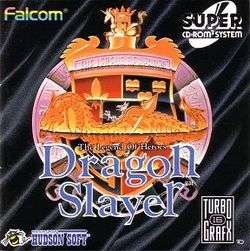Dragon Slayer: The Legend of Heroes
| Dragon Slayer: The Legend of Heroes | |
|---|---|
 | |
| Developer(s) | Nihon Falcom |
| Publisher(s) |
Nihon Falcom, Hudson Soft (TCD)[1] |
| Composer(s) |
Mieko Ishikawa Masaaki Kawai |
| Series |
Dragon Slayer The Legend of Heroes |
| Platform(s) | NEC PC-8801, NEC PC-9801, FM Towns, MSX 2, TurboGrafx-CD, Super Famicom, Sharp X68000, Mega Drive, Satellaview, Microsoft Windows, PlayStation, Sega Saturn, Virtual Console |
| Release date(s) |
NEC PC-8801
MSX TurboGrafx-CD Super Famicom Mega Drive |
| Genre(s) | Role-playing game |
| Mode(s) | Single player |
Dragon Slayer: The Legend of Heroes is a role-playing game developed by the Nihon Falcom. It is the sixth game in the Dragon Slayer line of games, and the first in The Legend of Heroes series.
It was originally released in 1989 for the NEC PC-8801. Within the next few years it would also be ported to the NEC PC-9801, MSX 2, Sharp X68000, Sega Mega Drive, Super Famicom and the TurboGrafx-CD (PC Engine CD-ROM). A Dragon Slayer: The Legend of Heroes Barcode Battler card set was also released by Epoch Co. in 1992. The PC Engine version was released in the United States for the TurboGrafx-CD and was the only game in the series released in the US until The Legend of Heroes: A Tear of Vermillion, the PlayStation Portable remake of The Legend of Heroes IV: Akai Shizuku.
In 1995, a version of the game was broadcast exclusively for Japanese markets via the Super Famicom's Satellaview subunit under the name BS Dragon Slayer Eiyu Densetsu. In 1998, a remake of The Legend of Heroes was bundled with a remake of Dragon Slayer: The Legend of Heroes II and was released for both the PlayStation and the Sega Saturn.
The game's soundtrack was composed by the Falcom Sound Team JDK members Mieko Ishikawa and Masaaki Kawai. The soundtrack for the TurboGrafx-16 version was arranged by Ryo Yonemitsu.[6]
Reception
Upon release, Famitsu scored the PC Engine CD-ROM version 29 out of 40 in 1991.[1] They later scored the Super Famicom version 29 out of 40 in 1992,[4] and the Sega Mega Drive version 23 out of 40 in 1994.[5]
In its January 1993 issue, Electronic Games magazine's Electronic Gaming Awards nominated the TurboGrafx-CD version for the 1992 Multimedia Game of the Year award. They stated it "demonstrates how far multimedia has come" since the same design team's Ys I & II and that this "mammoth quest is meticulously detailed and incorporates highly involved game play."[7]
References
- 1 2 http://www.famitsu.com/cominy/?m=pc&a=page_h_title&title_id=11970
- ↑ http://www.famitsu.com/cominy/?m=pc&a=page_h_title&title_id=26637
- ↑ GamePro, issue 40 (November 1992), page 22
- 1 2 http://www.famitsu.com/cominy/?m=pc&a=page_h_title&title_id=9222
- 1 2 http://www.famitsu.com/cominy/?m=pc&a=page_h_title&title_id=940
- ↑ "Perfect Collection Dragon Slayer: The Legend of Heroes". VGMdb. Retrieved 16 May 2012.
- ↑ "Electronic Gaming Awards". Electronic Games (38): 26–7. January 1993. Retrieved 5 February 2012.
External links
- English game audio samples at AudioAtrocities.com
- Dragon Slayer: Legend of Heroes GUIDE (TurboGrafx-CD) and Dragon Slayer: Legend of Heroes PREVIEW at TurboPlay Magazine Archives